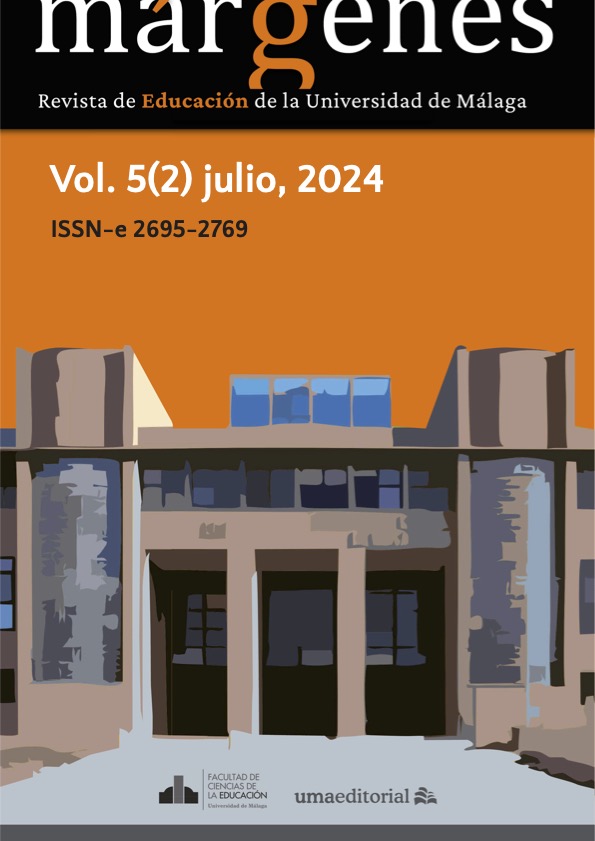Vitoria-Gasteiz educating city and cradle of municipal nursery schools, a paradigm of emotional wellbeing and good treatment
DOI:
https://doi.org/10.24310/mar.5.2.2024.19307Keywords:
Nursery schools, early adverse experiences, pedagogical practice, Educational action research, teacher trainingAbstract
This educational research analyses the relational and organisational model of the Municipal Nursery Schools of Vitoria-Gasteiz (EIMUVG), an educating city, which coincide in their daily work with some key principles of the new curriculum: good treatment, the pupils' sense of belonging and emotional well-being. It also warns about the situation of students who have experienced early adversity, identified in the scientific literature as ACE students. The EIMUVG educational model is analyzed as a reference of good pedagogical and inclusive practices.. A research-training-action process is carried out over a year between all the teaching staff of the EIMUVG (85 people) and the UPV/EHU research team (11 people). The research methodology is based on four cycles of reflection-action, involving 30 focus groups, participatory and creative techniques such as the World Coffee, and guaranteed dialogue between theory and pedagogical practice. The information is collected and analysed by means of a qualitative strategy and crystallised (Moral, 2016) with the help of the Nvivo 12 software. The results evidence a pedagogical model that is based on community engagement and that prioritises children's well-being, putting into practice consciously nurturing pedagogical relationships and environments. Mutual care and good treatment are identified as the relational model that determines the health. It is concluded that it is necessary to extend the model to all educational stages as, at the same time as it educates, it welcomes and protects.
Downloads
Metrics
Publication Facts
Reviewer profiles N/A
Author statements
Indexed in
-
—
- Academic society
- N/A
- Publisher
- Universidad de Málaga
References
Aigneren, M. (2009). La técnica de recolección de información mediante grupos focales. La Sociología En Sus Escenarios, (6). https://bit.ly/43i8GqL
Álvarez Blanco, L. (2019). Modelos teóricos de la implicación familiar: responsabilidades compartidas entre centros educativos, familias y comunidad. Aula abierta, 48(1), 19-30.
https://doi.org/10.17811/rifie.48.1.2019.19-30
Aristizabal, P., Alvarez-Uria, A., Gamito, R., Garay, B., Gómez, A., Lasarte, G., Lekue, P., López de Arana, E., López-Velez, A., Martínez, J., Tresserras, A. y Ugalde, A.. (2020). Proyecto educativo de la red de escuelas infantiles municipales. Colección temas municipales. Servicio de Educación. Departamento de educación y cultura, Ayuntamiento de Vitoria Gasteiz. https://bit.ly/439iGT8
Asensio, M. (11 de octubre 2022). Adingabeen buru osasunaren arretan, hezkuntza arloarekin koordinatzea aldarri. Berria. https://bit.ly/3uUIExb
Aucouturier, B. (2004). Los fantasmas de acción y de la práctica psicomotriz. Graó.
Adamson, P. (2008). El cuidado infantil en los países industrializados: transición y cambio. Una tabla clasificatoria de la educación y los cuidados durante la primera infancia en los países económicamente avanzados. Innocenti Report Card Innocenti, 8. http://www.unicef-irc.org/publications/pdf/rc8_spa.pdf
Ainsworth, M.D. y Bell, S. M. (1978). Apego, exploración y separación, ilustrados a través de la conducta de niños de un año en una situación extraña. En J. Delval (Comp.), Lecturas de psicología del niño (Vol. 1). Alianza.
Asociación Internacional de Ciudades Educadoras. (2020). Carta de Ciudades Educadoras. https://www.edcities.org/carta-de-ciudades-educadoras/
Barudy, J. y Marquebreucq, A. P. (2009). Hijas e hijos de madres resilientes. Gedisa.
Benito, R. (4 de febrero de 2020). Epigenética, acogimiento y adopción: un motivo para la esperanza [Conferencia]. Ume Alaia, Vitoria-Gasteiz.
Beresaluce, R. (2009). Las escuelas reggianas como modelo de calidad en la etapa de educación infantil. Aula Abierta, 37(2), 123-130. https://bit.ly/48ILKlv
Bisquerra, R. (2003). Educación emocional y competencias básicas para la vida. Revista de Investigación Educativa, 21(1), 7-43. https://revistas.um.es/rie/article/view/99071
Bowlby, J. (1989). Una base segura: aplicaciones clínicas de una teoría del apego. Paidós.
Bowlby, J. (1993). El vínculo afectivo. Paidós.
Colley, D. y Cooper, P. (Eds.) (2017). Attachment and Emotional development in the classroom. Theory and Practice. Jessica Kingsley Publising. https://doi.org/10.1080/13632752.2017.1366102
Craig, S. E. (2016). The Trauma-Sensitive Teacher. Educational Leadship, 74(1), 28-32. https://eric.ed.gov/?id=EJ1112050
Craig, S. E. (2017). Trauma-Sensitive Schools for the adolescent years. Teachers College Press.
Cyrulnik, B. (2009). La resiliencia o la capacidad humana de superar pérdidas, crisis, adversidades o traumas. Institut Francais.
David, M. y Appell, G. (2010). Loczy una insólita atención personal. Octaedro.
Davoli, M. (2008). Construir la escuela desde el niño: Perspectivas educativas en 0-3. Conferencia inaugural del 4º Encuentro Formativo de Escuelas Infantiles Municipales, Madrid.
De Castro, R.M. y Pereira, D. I. F. (2019). Education and Attachment: Guidelines to Prevent School Failure. Multimodal Technologies and Interaction, 3(1). https://doi.org/10.3390/mti3010010
Elliot, J. (2005). El cambio educativo desde la investigación-acción. Morata.
Erikson, M.F. y Egeland, B. (2002). Child neglect. En J. Myeres, L. Berliner, J. Briece, C. Hendrix, C, Jenny y T. Reid (Eds), The APSAC handbook on child maltreatment (2a ed.) (pp. 3-20). Sage.
Kamberelis, G. y Dimitriadis, G. (2015). Grupos focales. En Denzin, N. K. y Lincoln, Y. S, (Eds.). Métodos de recolección y análisis de datos (pp. 494-532). Gedisa.
Fancourt, N. y Sebba, J. (2018). The Leicestershire Virtual School’s Attachment Aware Schools Programme: evaluation report. The Rees Centre (University of Oxford, Departament of Education).
Felitti, V. J., Anda, R. F., Nordenberd, D., Williamson, D. F., Spitz, S. M., Edwards, V. y Marks, J. S. (1998). Relationship of child abuse and household dysfunction to many of the leading cause of deaths in adults: The adverse childhood experiences (ACE) study. American Journal of Preventative Medicine, 14, 245-258. https://doi.org/10.1016/s0749-3797(98)00017-8
Fernández, R. (2017). Las huellas de las experiencias tempranas en el cerebro. ¿Qué efecto tienen en el aprendizaje escolar? Mapas Colectivos.
Flick, U. (2012). Introducción a la investigación cualitativa. Morata.
Garay, B., Lasarte, G., Tresserras, A., López de Arana, E., Martinéz-Abajo, J. y Corres-Medrano, I. (2019). Cambiemos la mirada docente ante el alumnado que nadie quiere: De un problema de conducta a un tema de justicia social. En J. Murillo. y C. Martínez-Garrido (Coords.), Investigación comprometida para la transformación social: actas del XIX Congreso Internacional de Investigación Educativa (Vol. 1, pp. 351-356). Asociacion Interuniversitaria de Investigacion Pedagógica (AIDIPE). https://bit.ly/3v2BAi2
Garay, B., Lasarte, G., Corres-Medrano, I. y Santamaría-Goicuria, I. (2022). Why Should Educators Receive Training in Childhood Trauma? Trends in Psychology. https://doi.org/10.1007/s43076-022-00223-1
Giménez, M. y Quintanilla, V. (2009). Competencia social, competencia emocional: una propuesta para intervenir en Educación Infantil. Infancia y Aprendizaje, 32(3), 359-373. https://doi.org/10.1174/021037009788964222
Gobierno Vasco (9 de octubre del 2023). Irekia Eusko Jaurlaritza-Gobierno Vasco. https://bit.ly/3T6JDSZ
Gobierno Vasco (2014). Heziberri 2020: marco del modelo educativo pedagógico. https://bit.ly/3Tr5BRY
Goetz, J. P. y Lecompte, M. D. (1988). Etnografía y diseño cualitativo en investigación educativa. Morata.
Heckman, J. J. (2019). Early childhood education strengthens families and can break the cycle of poverty. Heckman The economics of human potential. https://bit.ly/49KFACS
Herrán, E. (Ed.) (2018). Claves de la Educación Pikler-Loczy. Realpress.
Kvale, S. (2011). Las entrevistas en Investigación Cualitativa. Morata.
Kamberelis, G. y Dimitriadis, G. (2015). Grupos focales. En N. K. Denzin y. S, Lincoln (Coords.), Métodos de recolección y análisis de datos, (pp. 494-532). Gedisa.
Löhr, K., Weinhardt, M. y Sieber, S. (2020). The “World Café” as a participatory method for collecting qualitative data. International journal of qualitative methods, 19, 1-15. https://doi.org/10.1177/1609406920916976
Malaguzzi, L. (2001). La educación infantil en Reggio Emilia. Octaedro.
Martínez-Miguelez, M. (2006). Ciencia y arte en la metodología cualitativa. Trillas.
Mcdowell, N. (2017). The association between adverse childhood experiences and educational outcomes among children ages 6-17. (Thesis). Georgia State Univesity.
Moral, C. (2016). Estrategias para resistir a la crisis de confianza en la investigación cualitativa actual. Educación XX1, 19(1), 159-177. DOI: 10.5944/educXX1.14227
Muñiz, M. (13 de noviembre del 2017). El impacto de la adversidad en la infancia temprana [Entrada en un blog]. Recuperado el 8 de marzo del 2024 de https://bit.ly/49FBX0W
Pinto, M. (1991). Análisis documental. Fundamentos y procedimientos. Eudema Universidad.
Rees Centre. (Junio de 2022). Alex Timpson Attachment and Trauma Awareness in Schools Programme. Recuperado el 08 de marzo del 2024 https://bit.ly/49Kq6Pk
Richardson, L. y St. Pierre E.A. (2017). La escritura. Un método de investigación. En N. K. Denzin e y. S. Lincoln (Eds.). El arte y la práctica de la interpretación, la evaluación y la presentación (pp. 128-163). Gedisa.
Rose, J., McGuire-Snieckus, R., Gilbert, L. y Maclnnes, K. (2019). Attachment Aware Schools: The impact of a targeted and collaborative intervention. International Journal of Pastoral Care and Education, 37(2), 162-184. https://doi.org/10.1080/02643944.2019.1625429
Ruiz de Velasco, A. y Abad, J. (2011). El juego simbólico. Graó.
Ruppert, F. (2019). ¿Quién soy yo en una sociedad traumatizada? Herder.
Rygaard, N. P. (2008). El niño abandonado. Gedisa.
Schalock, R, L. y Verdugo, M. A (2003). Calidad de vida: manual para profesionales de la educación, salud y servicios sociales. Alianza.
Silberg, J. (2019). El niño superviviente. Desclée de Brouwer.
Sporleder, J. y Forbes, H. T. (2019). The Trauma-Informed School. Beyond Consequences Institute.
Tresserras, A. (2017). Aportaciones a la formación del profesorado a través del análisis de una experiencia de arte y juego dramático en el primer ciclo de Educación Infantil. (Tesis doctoral). UPV/EHU, País Vasco. https://addi.ehu.es/handle/10810/22845
Van der Kolk, B. (2023). El cuerpo lleva la cuenta. Cerebro, mente y cuerpo en la superación del trauma. Eleftheria.
Vega-Arce, M. y Núñez-Ulloa, G. (2017). Experiencias Adversas en la infancia: revisión de su impacto en niños de 0 a 5 años. Enfermería Universitaria, 14(2), 124-130. http://dx.doi.org/10.1016/j.reu.2017.02.004
Web del maestro CMF. (23 de octubre de 2019). Jorge Barudy: Las neuronas espejo se recuperan en ambientes amorosos, donde fluye la empatía. Recuperado el 8 de marzo de 2024 de https://bit.ly/3IxgawG
Ziegler, D. (2011). Traumatic Experience and the Brain: A Handbook for Understanding and Treating Those Traumatized as Children. Acacia Publishing.
Downloads
Published
How to Cite
Issue
Section
License
Copyright (c) 2024 Márgenes Revista de Educación de la Universidad de Málaga

This work is licensed under a Creative Commons Attribution-NoDerivatives 4.0 International License.
The editorial team of Márgenes supports an open Access policy of scientific knowledge. apostamos claramente por una política de acceso abierto del conocimiento científico (see Berlin Declaration).
Authors with work published in this journal accept the following conditions:
- This journal provides immediate free access to its content under the principle of making research freely available to the public. All contents published in Márgenes are subject to the Creative Commons Reconocimiento-SinObraDerivada 4.0 Internacional
It is the responsibility of the authors to obtain the necessary permissions of the images that are subject to copyright.
Authors whose contributions are accepted for publication in this journal will retain the non-exclusive right to use their contributions for academic, research and educational purposes, including self-archiving or deposit in open-access repositories of any kind.
The electronic edition of this magazine is edited by the Editorial of the University of Malaga (UmaEditorial), being necessary to cite the origin in any partial or total reproduction.
- Authors can enter into other additional independent contractual agreements for the non-exclusive distribution of the version of the article published in this journal (e.g. including it in an institutional repository or publishing it in a book) on the condition that they clearly indicate that the work was originally published in this journal.
- Authors are allowed and recommended to publish their work on the Internet (for example on institutional and personal websites), before and after the publication, as this could lead to constructive exchanges and a more extensive and quick circulation of published works (see The Effect of Open Access).















